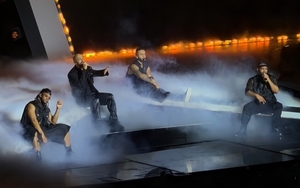GOTHIC was first an insult.
In 2015 it could be argued the Gothic style has never been so prominent in popular culture
Renaissance Italian artists and writers in love with the exact proportions, balance and intellectual rigour of Classical art - in particular architecture - looked back on the recent past and tagged it Gothic, aka 'barbaric'. All those pointed arches, shadowy recesses, seemingly random towers, finials (decorative mini-spires), soaring vaults, gargoyles, appeared overly emotional, hysterical, monstrous to artists such as Raphael who popularised the phrase. The next major movement of European thought, the Enlightenment, felt the same. Gothic art was part of a nasty past.
The Gothic Revival hit home first in the UK in the late eighteenth century and then spread through much of Europe. The new acolytes wanted that heightened emotion, they wanted to feel as well as rationalise. They loved Gothic precisely because it was not Classical and cold. Horace Walpole's Strawberry Hill mansion followed by his novel the Castle of Otranto and subsequently Mary Shelley's novel Frankenstein cemented the genre in the minds of the passionate and the fey, lovers of 'a pleasing sort of horror'.
Architecture followed the change of mood.
To begin with Gothic architecture in Manchester, as elsewhere, fitted the romance and drama of the early Gothic revival, see All Saints church below. Then in the 1840s John Ruskin began to champion the Gothic as the purest form of architecture and a model to all art if artists wished to be naturalistic, honest, sincere, true. By extension Gothic was far more than a fashion or style instead it was a model for a worthy, engaged and fulfilling life.
Soon Gothic buildings began to copy exactly the motifs of medieval originals. Gothic was all the rage, the wheel had come full circle. Alfred Waterhouse with buildings in Manchester such as the Assize Courts, destroyed in WWII, and the Town Hall exploited the style to produce masterworks of Victorian Gothic.
There's a sweet irony here. Ruskin was inspired in his love of Gothic as much by his abhorrence of the mechanistic and mass-produced character of the Industrial Revolution as he was by antipathy to the cold certainties of the Classical style. Curious then that the most industrialised city on the planet at the time embraced the Gothic style so wholeheartedly.
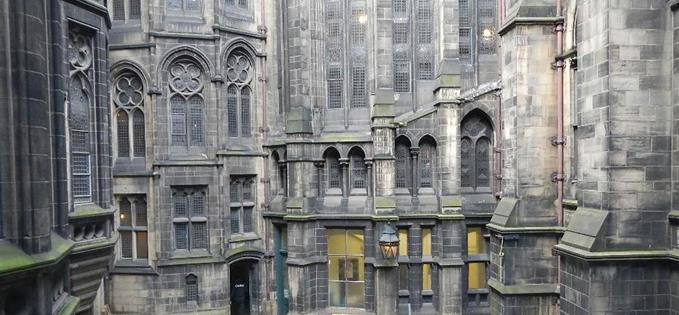 Feel the Gothic - Manchester Town Hall courtyards
Feel the Gothic - Manchester Town Hall courtyardsArtists and writers such as Edgar Allan Poe, Bram Stoker and HP Lovecraft continued to provide ‘a pleasing and not-so-pleasing sort of horror’ just as Gothic architecture fell utterly out of fashion in the decades before WW1. Yet the style, transformed into more of a mood or state-of-mind than anything physical, survived in novels and film. It became a musical and fashion phenomenon, for some a lifestyle, by the 1970s and 1980s. In 2016 it could be argued it’s never been so prominent, with a Centre for Gothic Studies at Manchester Metropolitan University for instance.
Below is our selection of the best in Gothic architecture in the Manchester area, both original and nineteenth century.
For the full programme of Manchester Metropolitan University's Gothic Manchester Festival click here.
MANCHESTER'S BEST GOTHIC SITES:
ALL SAINTS | Stand
If Gothic is about heightened emotion, the other-worldly sensation rather than cool intellect, the porch and tower of Charles Barry's 1828 All Saints in Stand, Whitefield, has it all. Stretched way beyond the usual dimensions of church architecture of the period and completed twelve years after the publication of Frankenstein this western entrance with its 'vertinginous porch' according to The Buildings Of England architectural guides, simply needs mist and shadowy half-glimpsed human silhouettes to get one reaching for the garlic and the crucifix.
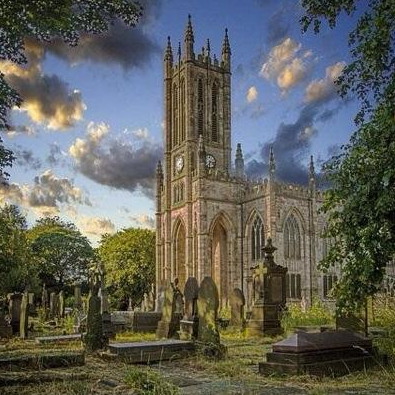

BARNES CONVALESCENT HOSPITAL | Cheadle
Part of the weird Italian/Spanish movie, The Living Dead at the Manchester Morgue, was filmed here in the 1970s. The trailer is hilarious, click here. Zombies were all the rage back then as well it seems. This could be Greater Manchester's Gothic horror pile without compare, abandoned for years, its empty corridors, eyeless towers and dank cellars have been a byword locally for scary goings on and sinister visitations. It was designed by Lawrence Booth and completed in 1875. The commission was from Manchester Royal Infirmary and the idea was to provide an airy rural retreat for those on the mend away from the smoky city centre. The fields it lay within are now a compass of motorways and the horror is perhaps in retreat as developers move in to convert the site into apartments. The name comes from a principal donor at the time, Robert Barnes.
 Barnes Hospital abandoned (image credit 28 Days Later)
Barnes Hospital abandoned (image credit 28 Days Later)CHETHAM'S SCHOOL AND COLLEGE HOUSE | Victoria
Dating from 1421 Chetham's was erected as priests' quarters for the nearby Collegiate Church, now the Cathedral. After the English Civil War it became a school and library through the will of Humphrey Chetham. The date of this building makes it genuinely Gothic and it feels it. Age and antiquity is palpable as you walk the halls and corridors. In the Audit Room there is a Hell Mouth, a roof boss of a devil swallowing a soul; nearby is a table with a hoof-shaped burn mark where alchemist and scholar Dr John Dee is said to have raised the Devil. Perfect. You can tour the whole building on these tours.
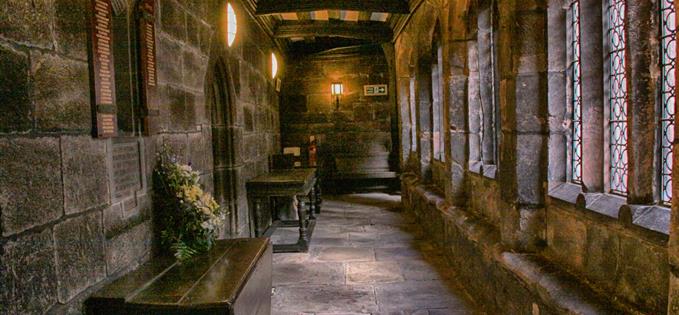
 Hell mouth in the Audit Room
Hell mouth in the Audit Room Enter into the Gothic
Enter into the GothicJOHN RYLANDS LIBRARY | Deansgate
This has been described as the best of the late Victorian Gothic buildings in the UK. Finished in 1899, opened in 1900, Basil Champneys' masterpiece for Enriqueta Rylands commemorating her husband, the textile magnate John Rylands, is designed with Gothic fantasy in mind. There are dark passageways, doors that might lead anywhere, balconies that appear inaccessible and even a ghost in the ladies toilet. The quality of carving, the grotesque heads and strange beasts that appear everywhere adds to the atmosphere as does the beautiful light Art Nouveau by Singer's of Frome. The tortured Nouveau of the lamps above the Reading Room tables clearly come straight from a house sale at Dracula's castle.
 The Reading Room (image credits Emma Golpys)
The Reading Room (image credits Emma Golpys)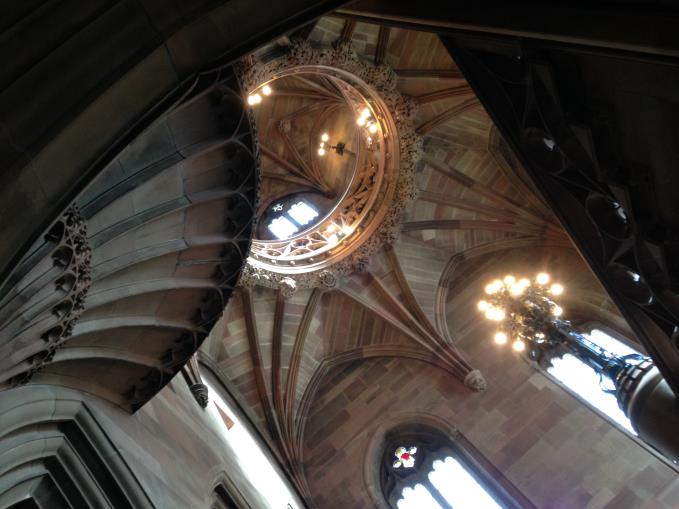 Gothic symphony
Gothic symphony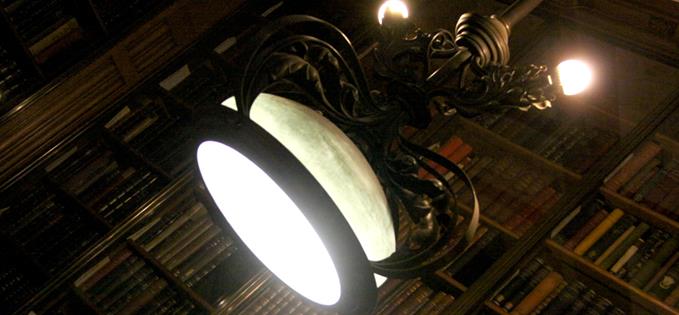 Horror by light fitting
Horror by light fitting  Is this the scary section?
Is this the scary section?LAW LIBRARY | City Centre
Thomas Hartas seems to have built very little of record, yet he designed the Manchester Law Library in 1885 and created an absolute cracker. This is a sublime mesh of windows patterned by quatrefoil (four leaf) tracery and finials and also an often unregarded component of architecture, beautifully crisp carved text that could have been lifted from an illuminated manuscript.
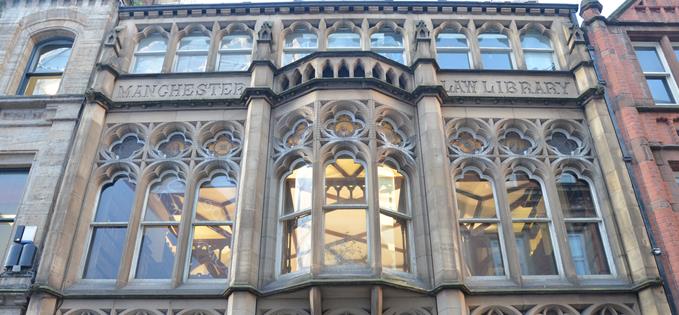
MANCHESTER CATHEDRAL | City Centre
Again authentic Gothic, as with Chetham's, takes centre-stage here. In the century after the 1420s, as the church was hugely expanded, we have a wealth of detail both mysterious and charming. The choir is the centrepiece, a series of perfect churches canopying the stalls where the clergy sit, a forest of finials while underneath the chairs there's a superb series of carved reliefs both allegorical and secular. There are wodewose's carved here, aka wildmen, covered in hair like a beast and usually armed with a symbolic club. They fight monsters, mythical beasts or each other. Wodewoses fit perfectly modern interpretations of the Gothic: they are the embodiment of unreasoned, uncontrolled passion, they are madness, anger and insatiable lust. Nearby a dragon surveys the scene: dragon's are the Devil's beast or old Beezelebub himself.
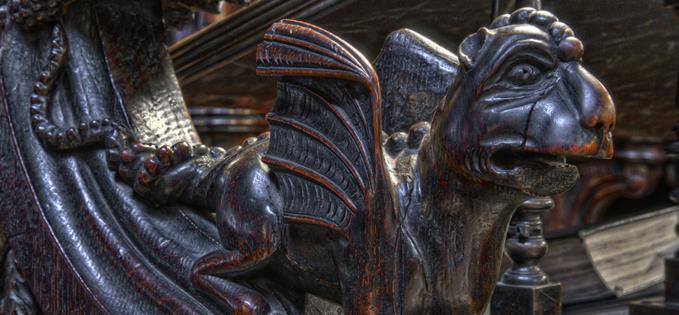 The Devil with fire and wings
The Devil with fire and wings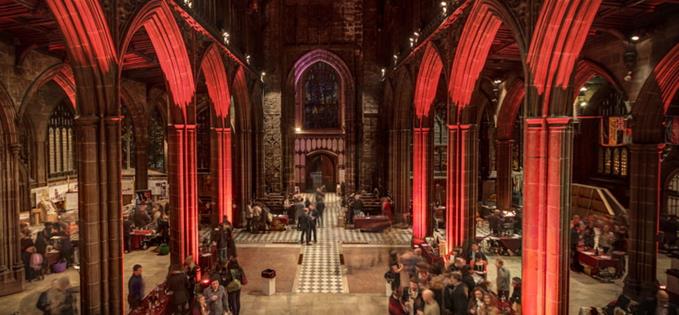 Red in the Cathedral
Red in the Cathedral Choir stalls
Choir stalls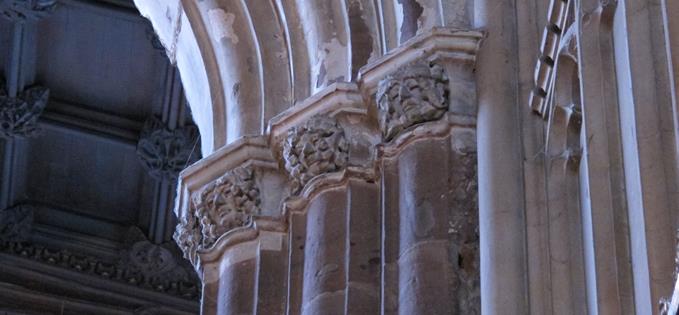 Manchester's benign Green Men - pre-Christian symbols of rebirth
Manchester's benign Green Men - pre-Christian symbols of rebirthMANCHESTER GENERAL CEMETARY | Harpurhey
Amidst the trees and the tall monuments at that far end of this mini-Manchester Highgate from 1837 you'll find broken pillars, carved hourglasses with the sand run out, fallen tombs and vaults housing dead merchants, industrialists, professionals, the middle-classes and lowly foundlings. The latter, abandoned children and their sad little graves paid for by benefactors or public subscription, dot the cemetery. Over a broken fence to the west there is bumpy terrain. This was where the common graves were located. These graves contain hundreds who couldn't afford a private grave. If you're feeling a Gothic melancholy this place is perfect for a wander at dusk.
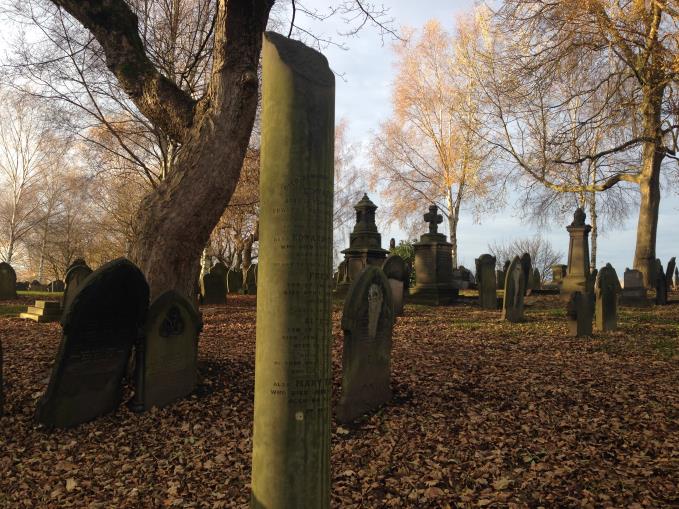 A broken pillar at Manchester General Cemetery of a life cut short
A broken pillar at Manchester General Cemetery of a life cut shortMANCHESTER TOWN HALL | City Centre
Alfred Waterhouse's 1877 Manchester showpiece is an obvious inclusion here but unavoidable. Although Waterhouse always insisted this was a modern practical building it would also be fine for filming Edgar Allan Poe's chilling Masque of the Red Death. Hidden nooks, crannies, detail on every wall, dramatic twisting staircases would be just right for Prince Prospero's palace. Particularly moody are the courtyards, blackened by smoke, and the stuff of nightmares as night falls. Andrew Brooks' pictures from the bell tower replete with stony angels can scarcely be bettered as a Gothic vision.
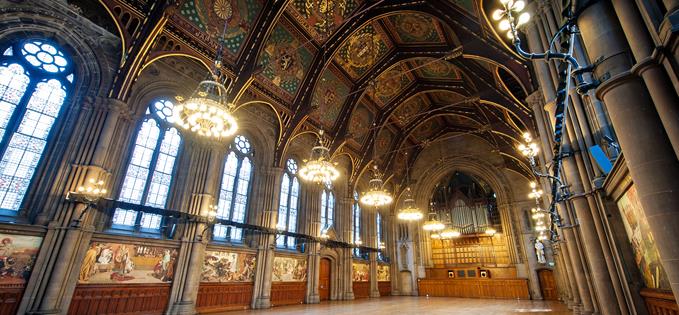 Great Hall
Great Hall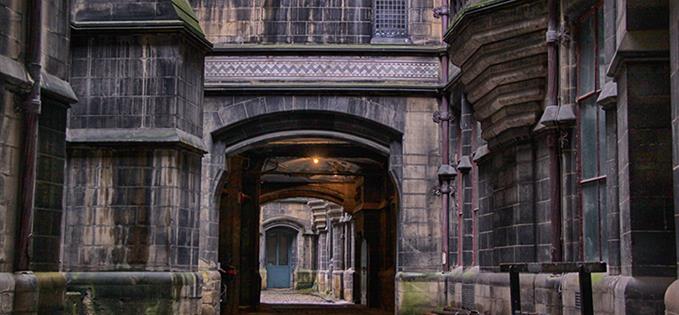 The shadowy courtyards (photo credit Emma Golpys)
The shadowy courtyards (photo credit Emma Golpys) Arch beyond arch
Arch beyond arch Tower gargoyle
Tower gargoyle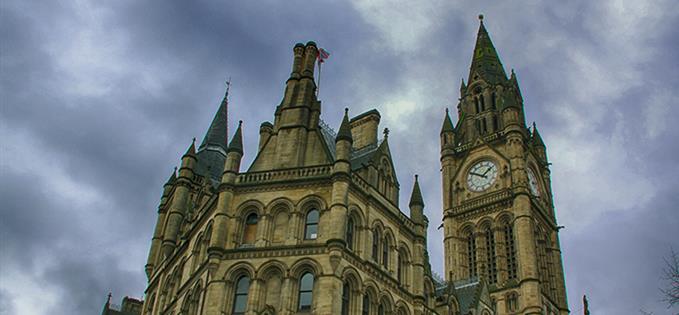 Rushing clouds
Rushing cloudsPALACE HOTEL | CITY CENTRE
Yes, this is cheating because the old Refuge Assurance building, now the Palace Hotel, is a neo-Renaissance structure. But the directors staircase from 1910-1912 by Alfred Waterhouse's son, Paul, may have not be Gothic stylistically but by all the demons of hell and all the angels of mercy it is one of the most spooky, atmospheric, Gothic in character spaces in the city. The main materials used are marbles in deep green through to pure white. There are translucent stones as well; yellow onyx in oval panels. But the most shiversome features are the lampfittings which are the most vampiric detail in any building in Manchester along with the lightfittings in John Rylands Library Reading Room. There's a ghost too. A member of staff's fiancee was killed in the trenches in WWI. His distraught lover threw herself down the stairwell. So as you wander beware the disembodied scream of that doomed woman.
 Terrifyingly impressive
Terrifyingly impressive Beware the scream
Beware the screamST AUGUSTINE | Pendlebury
Laurence Stephen Lowry, Greater Manchester's miserablist artist, recognised the Gothic madness in this ineffably beautiful Victorian church from 1874 by GF Bodley. His 1924 image of the Pendlebury building in Salford brings to mind that master of the heightened sensibility, Caspar David Friedrich, with his The Abbey in the Oak Forest from 1810 - Friedrich, a German artist, was pitch-perfect for the heyday of re-invented Gothic as an emotional force at the beginning of the nineteenth century. St Augustine has got people hot under the collar, not least architectural guru Nikolaus Pevsner who wrote that it 'is one of the English churches of all time. It's sheer brick exterior and the majestic sursum (Latin for 'heart lifting') of its interior have never been surpassed in Victorian church building'.
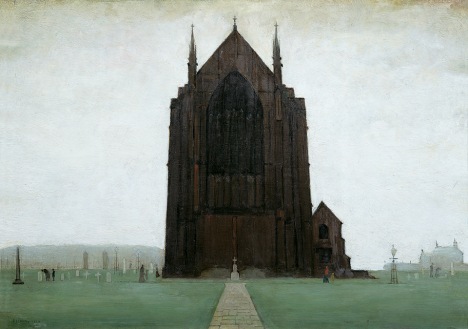 Lowry's St Augustine
Lowry's St Augustine Casper David Friedrich's The Abbey in the Oak Forest bears a Gothic resemblance to the Lowry work
Casper David Friedrich's The Abbey in the Oak Forest bears a Gothic resemblance to the Lowry work That 'heart-lifting' interior - pic from Xavier de Jauréguiberry's excellent series
That 'heart-lifting' interior - pic from Xavier de Jauréguiberry's excellent series ST LUKE'S | Cheetham Hill
The celebrated German composer and musician Felix Mandelssohn played the organ here on 17 April 1847, when this church was a centrepiece of a very upmarket Cheetham Hill. The church was finished in 1839 and designed by TW Atkinson. It once supported a spire, now all that is left is the magnificent ruin of the west front, with the sky peeping through the empty eye-sockets of broken tracery. The crazy relic has also been celebrated on TV too, the shattered church appearing in an episode of Prime Suspect in 1996. There must be something about the name St Luke and ruins, Liverpool's best ruined church, the blitzed St Luke, sits on Berry Street in the city centre.

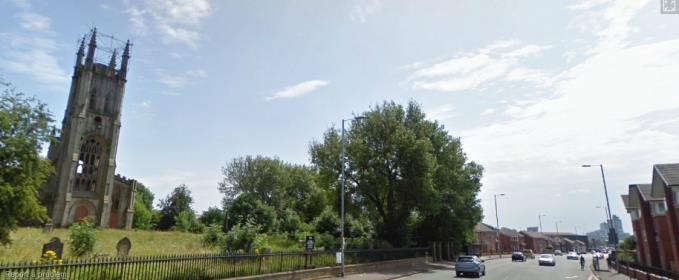 St Luke's from Cheetham Hill Road
St Luke's from Cheetham Hill Road READ MORE:
- The Best Of Manchester's Lost Buildings
- Manchester's Best DoorwaysYou can follow Jonathan Schofield on Twitter @JonathSchofield or connect via Google+ You can buy his guidebook to Manchester here and join one of his tours here.









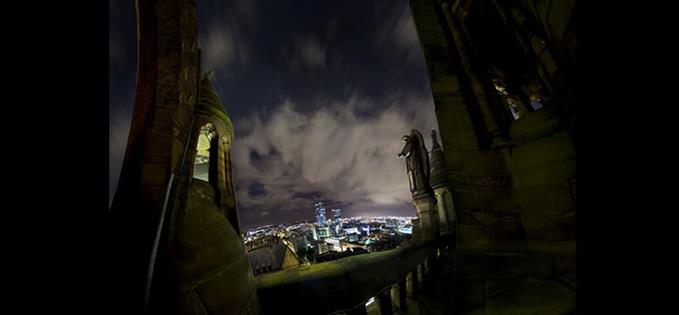 The
The 


